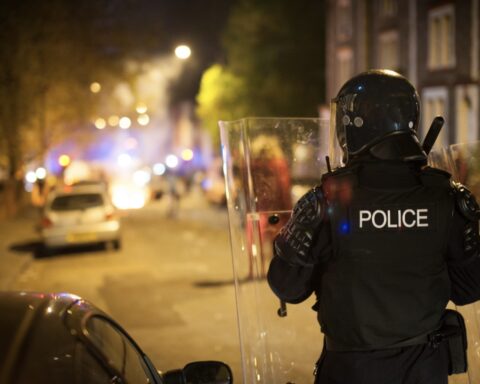An expert in policing suggests that more training is required to support law enforcement officers intervening in immigrant-related situations, following renewed interest in the death of a Polish immigrant at Vancouver International Airport in 2007.
This incident is one of many in the past few years that involved excessive use of force by Canadian police during confrontation with immigrants.
Almost eight years after Royal Canadian Mounted Police (RCMP) officers at Vancouver International Airport (YVR) killed Robert Dziekanski, this issue has come under scrutiny now that the widow of a late Mountie has filed a civil suit against the RCMP.
Sheila Lemaitre is claiming that her husband, who became the face of the Dziekanski case, committed suicide as a result of post-traumatic stress disorder (PTSD) and trauma exacerbated by the RCMP following the incident.
The filing of the civil case has spurred renewed concerns as to the use of excessive force by police officers, in particular with racial minorities and immigrants in Canada.
In her statement of facts, filed on July 30 in British Columbia’s Supreme Court, Lemaitre claimed that her late husband’s death was a “result of severe conditions, which were a direct result of his service in the RCMP and the negligence of the RCMP.”
Lemaitre’s husband, Pierre, who was the spokesperson for the RCMP following Dziekanski’s death, took his own life on July 29, 2013.
Due to the ongoing nature of the civil suit, the RCMP nor Lemaitre or her lawyer were willing to comment.
Not an isolated incident
The filing of the civil case has spurred renewed concerns as to the use of excessive force by police officers, in particular with racial minorities and immigrants in Canada.
The death of Dziekanski gained international media interest after it was revealed that the RCMP had misled the public as to the circumstances around his death.
On October 14, 2007, a disoriented Dziekanski wandered YVR for several hours before being detained by RCMP officers.
Dziekanski, who had just arrived from Poland and did not speak English, became agitated and was later killed during an attempt by police officers to subdue him.
Pierre described Dziekanski to the media as combative and stated that the police’s quick use of a Taser stun gun was justified. Press releases also stated that Dziekanski had only been tasered twice.
However, an amateur video of the incident contradicted the RCMP’s claims, revealing that Dziekanski had been tasered five times, several of which occurred after he had fallen to the ground. It was this excessive use of force by police that ultimately led to Dziekanski’s death.
[youtube height=”315″ width=”560″]https://www.youtube.com/watch?v=1CR_k-dTnDU[/youtube]Police use of force against racial minorities has been a controversial topic in the media, particularly in the United States, following the 2014 police shooting of Michael Brown.
Dziekanski is not the only time police have had fatal interactions with immigrants suffering from apparent mental illness.
While police use of force is much more prevalent in the United States, Dziekanski is not the only time police have had fatal interactions with immigrants in Canada.
Just this year, Andrew Loku, a South Sudanese immigrant, was shot and killed by Toronto police officers in his apartment complex. Like Dziekanski, witnesses suggest that Loku may have been in crisis at the time of his death.
When police responded to a call about unknown trouble, Loku allegedly refused to comply with their demand to drop the hammer he was holding and he began approaching the police. One witness claims police only gave this order once before one of the officers began shooting.
Loku was a new immigrant to Canada, working so that he could eventually bring the rest of his family over from South Sudan. He was living in an apartment complex subsidized by the Canadian Mental Health Association.
In another incident last year, Vancouver police shot and killed Phuong Na (Tony) Du, an immigrant from rural Vietnam.
Du had been acting distraught and waving a piece of lumber when police confronted him at an intersection in Greater Vancouver. It was later revealed that Du had been suffering from schizophrenia.
Training not adequate enough
In a study conducted at the University of Toronto, researchers found that certain racial minorities were overrepresented in instances of police use of force.
African Canadians were at particular risk, for example, representing almost 50 per cent of all deaths caused by police use of force and two-thirds of all deaths caused by police shootings.
However, South Asian, Asian and West Asian Canadians were underrepresented.
While there may be many explanations for these trends, political scientist Stuart Farson maintains that these fatal shootings reveal a serious need for special training within the RCMP.
“Individual police officers often have only moments to respond to a person who appears to be threatening someone,” he explains.
“There is evidence to suggest that training has not been as adequate as it should have been. Given that the mentally ill have a tendency to come into contact with the police in potentially life threatening situations, such training should be an essential part of ongoing training.”
Political scientist Stuart Farson suggests that recruiting officers that better reflect the communities they serve and who can speak the languages of Canada’s immigrant populations may mitigate such incidents.
A professor at Simon Fraser University and author of numerous articles on security, intelligence, policing and political violence, Farson conducted research into the security operations at YVR several years ago.
He says the department was a “very cosmopolitan place” with members representing various ethnic groups. As such, he was surprised that officers at the time failed to properly intervene with Dziekanski.
“While it is clear to me that what happened to Robert Dziekanski was utterly shameful, I believe it should never have happened,” he states.
Farson suggests that recruiting officers that better reflect the communities they serve and who can speak the languages of Canada’s immigrant populations may mitigate such incidents.
However, he adds recruiting from visible minorities is no easy feat. “Some communities have tended to be very reluctant to join.”





